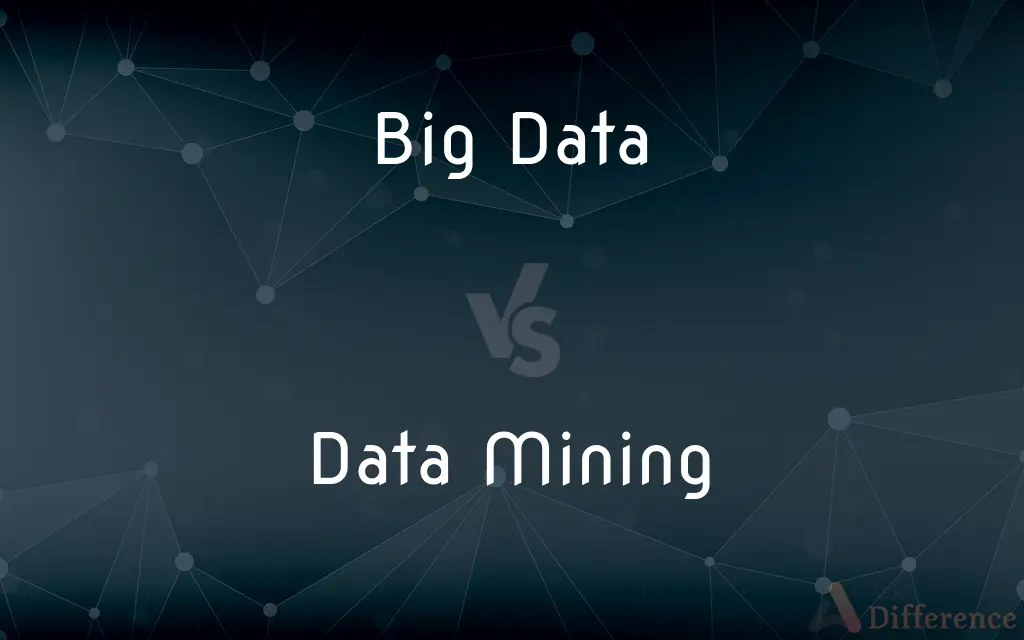Big Data vs. Data Mining — What's the Difference?
By Tayyaba Rehman — Published on January 12, 2024
Big Data refers to vast volumes of data that are too large to be processed by traditional methods. Data Mining is the process of discovering patterns, insights, and knowledge from large datasets.

Difference Between Big Data and Data Mining
Table of Contents
ADVERTISEMENT
Key Differences
Big Data encompasses the massive volume of data generated daily from various sources, including sensors, social media, and digital devices. It surpasses the capacity of traditional data processing tools and requires specialized techniques for storage, management, and analysis. The key characteristics of Big Data are often described using the "3Vs": volume (large amounts of data), velocity (rapid data generation), and variety (diverse data types).
Data Mining is a subset of Big Data analytics. It involves the exploration of large datasets to discover valuable insights, hidden patterns, and trends. Data Mining employs various techniques, such as machine learning, statistical analysis, and artificial intelligence, to extract meaningful information from data. The goal is to transform raw data into actionable knowledge, enabling better decision-making and predictions.
The primary difference lies in their focus and purpose. Big Data pertains to the vastness and complexity of data itself, addressing challenges related to its storage, processing, and management. Data Mining, on the other hand, is a process or methodology used to extract valuable insights and knowledge from Big Data. It leverages Big Data's volume and variety to uncover patterns and make data-driven decisions.
Big Data is prevalent across industries, including finance, healthcare, e-commerce, and more, where enormous datasets are generated daily. Data Mining finds applications in customer behavior analysis, fraud detection, recommendation systems, and scientific research, among others, by extracting meaningful information from Big Data.
Comparison Chart
Definition
Vast volumes of data
Process to extract insights
ADVERTISEMENT
Focus
Data volume, velocity, variety
Knowledge discovery
Challenges
Storage, processing, management
Pattern extraction, analysis
Techniques
Data storage, parallel computing
Machine learning, statistics
Applications
Across industries
Customer analysis, research
Compare with Definitions
Big Data
Large, diverse data volumes.
Big Data in healthcare records.
Data Mining
Enhances decision-making.
Data Mining for fraud detection.
Big Data
Big Data refers to massive datasets.
Analyzing Big Data from social media.
Data Mining
Part of Big Data analytics.
Data Mining in healthcare research.
Big Data
Includes data from various sources.
Big Data from IoT devices.
Data Mining
Discovering patterns in data.
Data Mining in retail sales.
Big Data
Often characterized by 3Vs.
The 3Vs of Big Data.
Data Mining
Utilizes machine learning.
Data Mining with decision trees.
Big Data
Challenges traditional data tools.
Processing Big Data with Hadoop.
Data Mining
Data Mining extracts insights.
Data Mining for market trends.
Common Curiosities
What challenges does Big Data pose?
Big Data challenges include data storage, processing, and management due to its vastness.
What is Big Data?
Big Data refers to the vast volume, velocity, and variety of data generated from various sources.
How does Big Data differ from Data Mining?
Big Data refers to the data itself, while Data Mining is the process of extracting insights and patterns from Big Data.
What are some common applications of Data Mining?
Data Mining is used for customer behavior analysis, fraud detection, recommendation systems, and scientific research.
Give an example of Big Data in use.
Analyzing social media data with millions of user posts.
What are the main characteristics of Big Data?
The main characteristics are volume (large data amounts), velocity (rapid data generation), and variety (diverse data types).
What techniques are used in Big Data processing?
Techniques include distributed data storage and parallel computing.
Where is Big Data applied?
Big Data finds applications across industries, including finance, healthcare, and e-commerce.
What is Data Mining?
Data Mining is the process of discovering insights, patterns, and knowledge from large datasets.
What methods are used in Data Mining?
Data Mining employs techniques such as machine learning, statistical analysis, and artificial intelligence.
How does Data Mining enhance decision-making?
Data Mining uncovers patterns and insights that inform better decision-making.
Is Data Mining part of Big Data analytics?
Yes, Data Mining is a subset of Big Data analytics, focusing on knowledge discovery.
How does Big Data contribute to scientific research?
Big Data helps analyze large datasets, aiding research in various fields, including genomics and climate science.
Provide an example of Data Mining in action.
Data Mining used in retail to discover purchasing patterns.
What are the key goals of Big Data analytics?
The goals include deriving insights, making predictions, and improving decision-making.
Share Your Discovery

Previous Comparison
FDM vs. TDM
Next Comparison
French Bulldog vs. Boston TerrierAuthor Spotlight
Written by
Tayyaba RehmanTayyaba Rehman is a distinguished writer, currently serving as a primary contributor to askdifference.com. As a researcher in semantics and etymology, Tayyaba's passion for the complexity of languages and their distinctions has found a perfect home on the platform. Tayyaba delves into the intricacies of language, distinguishing between commonly confused words and phrases, thereby providing clarity for readers worldwide.
















































